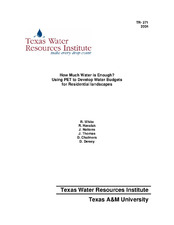| dc.description.abstract | Conserving and reducing the amount of water used for landscape irrigation continues to be a
major issue for municipalities throughout Texas and the nation. Landscape irrigation increases
dramatically during summer months and contributes substantially to peak demand placed on
municipal water supplies. A survey of monthly water use during 2000 through 2002 for 800
residences of similar size and appraised value in College Station, Texas indicated that average
peak water consumption increased as much as 3.3 fold during the summer compared to the nonpeak
months of December, January, and February. Although conservation education programs
typically suggest ways to reduce indoor and outdoor water use, information that can provide
homeowners with a realistic estimate of the amount of water required to sustain their landscape
at an acceptable quality is lacking.
Potential evapotranspiration (PET) modified by the appropriate crop coefficient is commonly
used to increase irrigation efficiency for crops and turf. However, very limited information
exists about landscape coefficients (Lc) for use in PET based irrigation of landscapes with
multiple plant species. Recent studies at Texas A&M University indicated that 0.70 appears to
be a good estimate of Lc to use in PET based landscape irrigation during the summer months.
Based on Lc, landscape size, and PET, water budgets were derived for 800 residential landscapes
to predict monthly residential water consumption and then compared with actual monthly water
used. These comparisons demonstrated seasonal water use patterns as well as the potential for
very large reductions in landscape water use. In 2000, 2001, and 2002, an average of 347, 410,
and 476 households, repectively, applied irrigation water in excess of PET. Had these
households applied landscape irrigation during May through October at 100% of PET, which is
equivalent to an Lc of 1.0, total predicted annual water savings for these households would have
been 74, 104, and 85 acre feet in 2000, 2001, and 2002, respectively. Had irrigation been
applied using an Lc of 0.7, the estimated savings would have totaled 92, 111, and 100 acre-feet
during the same period.
These data demonstrate the substantial potential that exists to conserve water used for landscape
irrigation by using PET, Lc, and landscape size to derive realistic water budgets. If adopted and
applied by homeowners, such budgets could result in very large reductions in landscape water
use. Historically, tools available to help water utilities curb outdoor water use in high demand
periods have included limitations on customers’ watering days and times and general
recommendations on how much water a landscape needs. Using PET combined with Lc has the
potential to provide realistic water budgets for residential landscapes and greatly reduce
landscape water use. Quantitative data showing the amount of water that landscapes need,
compared to how much water is typically applied to landscapes, will help utilities target their
conservation efforts for maximum results. | en |


